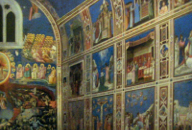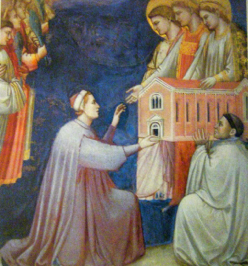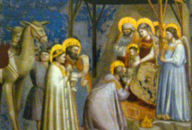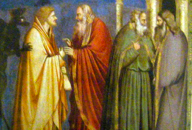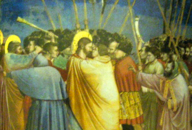Scrovegni Chapel
Padua, the Veneto
Northern Italy
Europe
November 5, 2008


Scrovegni Chapel
Padua, the Veneto
Northern Italy
Europe
November 5, 2008



The Scrovegni Chapel in Padua is a small, yet stunning chapel, beautiful in proportion, and completely covered on the interior with a cycle of frescoes by Giotto, completed in 1305. When I first visited this chapel thirty years ago, it was referred to as the “Arena Chapel” because of its location. Enrico Scrovegni had purchased land which abutted the Roman Arena in order to build this chapel next to his family’s palazzo on their large estate. The chapel was commissioned by Enrico Scrovegni, a wealthy moneylender who followed in the footsteps of his father, Reginaldo degli Scrovegni. Common belief is suggested that the son built the chapel to atone for the sins of his father, who was the usurer encountered by Dante in The Seventh Circle of Hell. Yet, more recent thought considers that Enrico himself may have built the chapel in an effort to atone for his own sins, as a usurer, as well. In the fresco of the Last Judgment, Enrico is portrayed presenting a model of the chapel to the Virgin. In either case, the chapel was dedicated to Santa Maria della Carita in 1303, serving principally as a family oratory and for some public functions related to the Feast of the Annunciation. The chapel is a simple space with a barrel vault. The first impression of the chapel is the beautiful color and the ceiling painted ultramarine blue, adorned with portrait tondos, and scattered with gold stars. The two long walls are arranged in three tiers of fresco groups, each with four two-meter square scenes, a sum of two dozen scenes total on the two facing walls. On the end walls, rounded in shape to accommodate the barrel vault, are two frescoes. The altar is on one end of the vault, facing Giotto’s fresco of the Last Judgment, above the entrance door, opposite. With back to the Last Judgment, while facing the altar, the top left row of the room is devoted to the story of the life of St. Ann and her son, John the Baptist. On the top tier of the right side of the room, facing the altar, is the Story of Mary, with scenes of the Annunciation on the arch nearest the ceiling and above the altar. The story of Christ begins here at the altar with the Visitation on the second tier, and follows on the middle and lower tiers around the entire room. The Adoration of the Magi, the Presentation of Jesus at the Temple, the Flight into Egypt, the Massacre of the Innocents, the Baptism of Jesus, the Wedding at Cana, the Resurrection of Lazarus, the Entrance of Jesus into Jerusalem, the Expulsion of the Money Lenders from the Temple, and the Betrayal of Judas, all illustrating scenes from the life of Christ. On the lowest tier, begin the scenes of Christ’s ultimate death and resurrection, beginning with the Last Supper, Jesus Washing the Feet of the Apostles, the Kiss of Judas, the Judgement, Flagellation, Calvary, the Crucifixion, Death, Resurrection, Ascension, and ending with the Pentacost. The Last Judgment, above the entrance to the chapel, depicts Christ beneath the gothic window. He is ringed with a rainbow aura of soft colors, with a gold leaf halo matching those of angels with trumpets. A host of angels are crowded above the seated figures representing the Apostles. Beneath the heavenly realm, the scene is divided into two, the left representing the good, or saintly, and the right representing hell, the underworld and the devil. The figures in hell are naked, loathsome, and tortured figures, depicted with a blue devil devouring some people, as flames and smoke encase the scene. The saintly side is somewhat damaged, but Giotto portrayed these figures in beautiful colors with flowing robes and halos with gold leafing. At the center, beneath Christ, is an empty cross at which kneels Enrico Scrovegni, making his presentation of the chapel to the Virgin. Along with Giotto’s trompe l’oeil architecturally painted niches, are other architectural schemes painted in this manner, fooling the eye in the pretense of carved stone or inlaid marble. An example of this is depicted in trompe l’oeil panels of painted faux marble on each wall, painted around the room beneath the colorful fresco cycles described above. Between these painted panels are “carved stone” panels, monochromatic rectangular panels painted in shades of gray. One side of the room, placed nearest the floor, are illustrations of human vices, while the wall on the opposite side has illustrations of the virtues. The vices include: Folly, Weakness, Pride, Injustice, Infidelity, Envy, and Desperation. The illustrated Virtues include: Prudence, Fortitude, Temperance, Justice, Faith, Charity, and Hope. With the painting style Giotto developed as a student of Cimabue, he virtually revolutionized art in the 14th century. His early Renaissance paintings depicted architecture in new and dynamic form, while also imbuing his human subjects with character and emotion. His sense of color, and clarity, combined with a fresh perspective and composition brought him many important commissions, most of which we can still enjoy today.
PHOTOS: Left Column: 1. View of the ceiling of the chapel with the Last Judgement fresco painted on the wall above the entrance door. 2. The Wedding of Mary and Joseph. 3. Adoration of the Maji. 4. Detail, Massacre of the Innocents. Center, Top: Detail, a depiction of Christ in Last Judgment. Center, Bottom: Scene from Last Judgment depicting Enrico Scrovegni presenting the chapel to the Virgin. Right Column: 1. Wall depicting the cycle of frescoes painted by Giotto. The top row on this wall illustrates the life of Saint Ann, the second tier illustrates stories from the life of Christ, the lowest tier illustrates the story of the crucifixion. 2. The Pentacost, Jesus meeting with his diciples after his spirit has ascended to heaven. 3. The Betrayal of Judas, depicted with a black devil figure behind him. 4. Judas’ Kiss, a composition which later inspired the Renaissance painter, Uccello.


A Giotto Masterpiece
